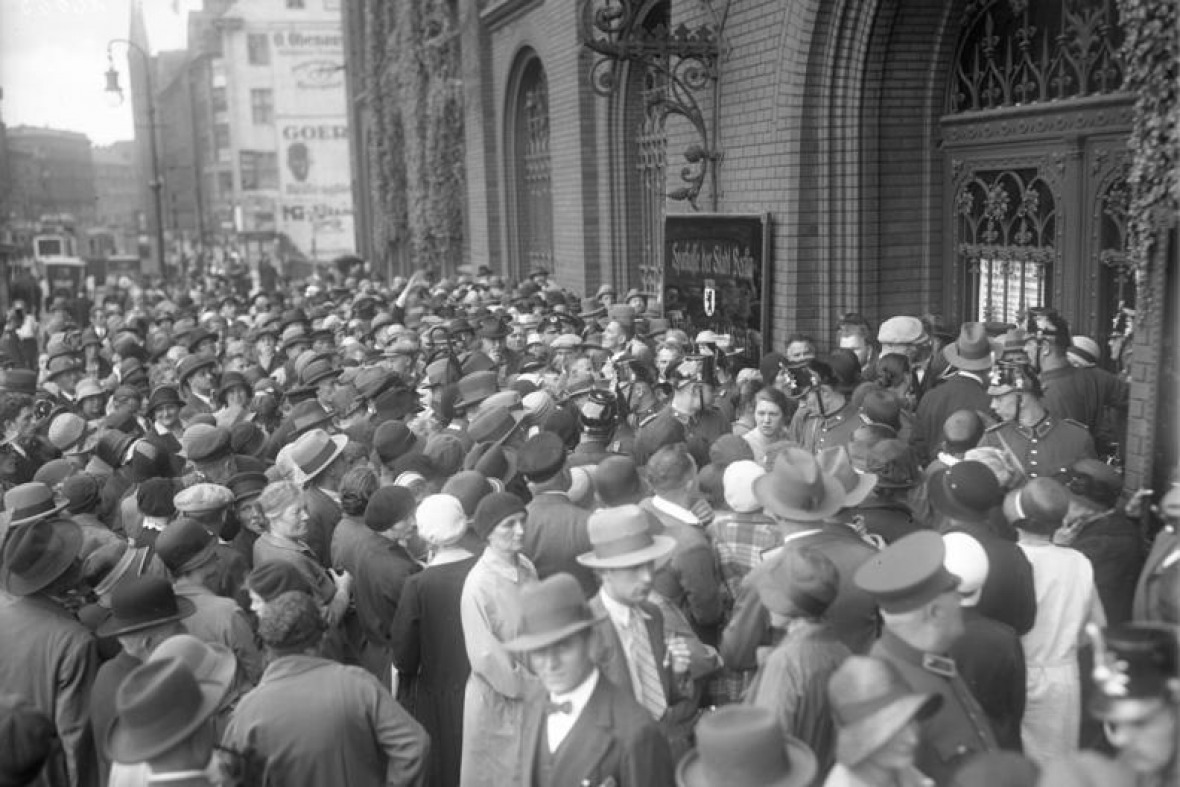“Shadow money should be tamed, not banned”
15.10.2018

Steffen Murau, a postdoc at Harvard University and IASS Affiliate Scholar, was recently awarded the K.-William-Kapp Prize of the European Association for Evolutionary Political Economy (EAEPE) for his journal article on “Shadow money and the public money supply” (2017). With a value of 1,000 euro, the prize is named after the economist Karl William Kapp, who drew attention to the social and ecological external costs of the market economy in his 1950s book “The Social Costs of Business Enterprise”.

Congratulations on being awarded the Kapp Prize of the European Association for Evolutionary Political Economy! In your article you analyse the impact of the 2007–2009 Financial Crisis on the monetary system. How did you approach that topic?
I did the empirical research for this article during a research stay at Columbia University in New York. It is based on publications by international financial institutions and interviews with employees of the Federal Reserve, banks, and the International Monetary Fund.
The article is based on one of the case studies I did for my PhD thesis. In the thesis I analysed how the ‘capitalist’ credit money system is transformed by financial crises. I was interested in how the 2007–2009 Financial Crisis changed how our monetary system operates, and I found that most research on the crisis lacked the monetary angle on what happened back then. Being a political economist, I also wanted to understand better the role that politics plays in that process, and not just the markets and bankers.
‘Shadow money’ plays a central role in your article. What exactly does the term mean?
We tend to think of money as something provided by the state. But, actually, most of the money we use is created by private institutions, first and foremost banks. Then there are different financial institutions that are not formally defined as banks and not regulated as banks, but which operate as if they were banks. We can call these types of firms ‘shadow banks’.
Regular banks are in the business of money creation. When they hand out a loan, they create bank money. We call this bank deposits. It has often been said and taught that banks need central bank reserves to create money. But this theory has been debunked, even by the Bank of England itself. I think of it as a ‘noble lie’ – as Plato would put it – that has been told to suggest that central banks have more control over the monetary system than is actually the case.
Now the idea of ‘shadow money’ is as follows: Some argue that shadow banking is the mere continuation of traditional banking by other means, in an unregulated segment of the financial system. If that is true, and I think it is, then shadow banks must also create some instruments that are similar to bank money. We can call these instruments ‘shadow bank money’ or ‘shadow money’ for short.
Can you give some examples of shadow money?
There are a number of instruments that emerged in the shadow banking system in the 1970s and 1980s which we can regard as substitutes for bank deposits and hence as shadow money: money market fund shares, asset-backed commercial papers, and overnight repurchase agreements (repos).
Until the 1970s, it was forbidden in the United States to pay more than two per cent interest on bank deposits. Then money market funds stepped in, offering shares as a substitute for bank deposits and paying higher interest on them. They were able to do so due to their status as funds rather than banks. Later even card payments became possible, making such funds practically indistinguishable from bank accounts in terms of the products they offered. The only difference being that they dealt in shadow money.
The asset-backed commercial paper market arose in the context of the international regulatory standards that oblige banks to build up reserves when they grant loans and thus draw on their customers’ deposits. However, since such reserves reduce profitability, the following trick was developed: The banks set up a “special purpose vehicle” in offshore financial centres – to all intents and purposes a letterbox company – and handled some of their lending business via that channel. Instead of bank deposits, they drew on asset-backed commercial papers that did not appear on their balance sheets. In this way, the rules on building up reserves could be circumvented and the banks’ profitability could be increased. When it boils down to it though, this is no different from ordinary credit money creation, apart from the fact that shadow money is used.
Finally, overnight repos are the very heart of the shadow money system. Legally speaking, an overnight repo is an agreement that I will sell you a security today and buy it back tomorrow at a slightly higher price. From an economics point of view, this is another way of creating credit. Hence, a parallel bank deposit system was created based on this principle. As a securities dealer, I trade in these securities and reinvest your money at a profit in the short time it is in my possession. From your point of view, you can ‘deposit’ money with me as you would in a current account and automatically withdraw it the next day. Or, we renew the repo contract every day, as is normally the case. The repo loan gives rise to shadow money; that’s your deposit, and hence I am a shadow bank.
We could find even more examples of shadow money. Different forms exist at different times and in different places. The story I tell here focuses on the US as the centre of the global monetary system. But there are different shadow money instruments in Europe, and yet others in China.
Shadow money sounds dodgy. Are those instruments real money or are they not?
When you dig deeper, you discover that there is no unanimous agreement on how to define money, or make a clear delineation between ‘money’ and ‘credit’. Karl Marx cites an English parliamentarian who said that “not even love has made so many fools of men as the pondering over the nature of money.”
I think that it is most useful to think of our modern money as a spectrum of different credit instruments. Today, the instruments created by central banks and banks are almost unanimously regarded as money, although that hasn’t always been the case. Other financial instruments are more opaque and fall into the shadow money category. They can be used as money during phases of financial expansion, and lose that status in a crisis.
Normally, discussions on money focus on the instruments created by central banks and banks. In my research on the monetary system, I find it most interesting and insightful to study the instruments at the edge of the spectrum, where everything gets blurry, and to address the problems of definition upfront. This is part of the intellectual challenge.
That sounds complicated. Couldn’t you just say then that any financial instrument is shadow money?
Actually, there are different theories about what shadow money is, and some scholars are also critical of the concept in general. In the approach I use, the key feature of shadow money is that it trades effectively at a one-to-one exchange rate with bank deposits. This one-to-one exchange rate is called ‘par’. We all know par implicitly from when we withdraw cash at an ATM. The money on our bank account has been created by a commercial bank. When we get bank notes, we convert it into central bank money. But since the exchange rate is one-to-one or par, we don’t see the difference between both. Just as bank deposits maintain par with central bank money, shadow money maintains par with bank deposits. This is the crucial aspect to appreciate when trying to get to grips with shadow money.

So how was shadow money connected to the Financial Crisis?
In the years and decades before the crisis, the instruments I look at ‘became’ shadow money because the financial institutions that created them managed to establish par between them and bank deposits. The way it worked was different for each form of shadow money, but in general we can say that firms took advantage of regulatory loopholes, creative accounting techniques, as well as private guarantees and insurance policies. This was all perfectly legal and watertight.
Due to the par exchange rate between shadow money and bank deposits, more and more large financial market participants began to use shadow money as alternatives to bank deposits. While we often hear about fraud and greed, those investors were not completely careless about what they invested in. The shadow money forms had private guarantees from banks and insurances. Before the crisis, there was a widely held belief that that those private guarantees were better than state guarantees for bank deposits because, in contrast to deposit insurance, they had no quantitative limit.
Think about it this way: When you are a hedge fund or a pension fund and you have billions that you want to ‘park’ short-term on a current account, you could go to a bank. But your money would only be insured for up to 100,000 USD or so. So you look for alternatives to bank deposits. Shadow money provided them.
The 2007–2009 Financial Crisis was an implosion of this shadow money scheme. The collapses of the investment banks Bear Stearns and Lehman Brothers were inherently connected to the parts of their businesses that were involved in shadow money creation. In the crisis, shadow money forms threatened to break away from par with bank deposits, and in many instances they did, especially after the Lehman collapse. For those who had invested billions and billions in those instruments, this meant that they were about to lose a lot of their wealth and probably go bankrupt. Investors initially thought that their shadow money was protected, but then the private guarantees turned out to be much weaker than everybody believed or even fraudulent.
Hence, what happened during the crisis was a run on shadow money. The investors no longer trusted the ability of shadow banks to maintain the par exchange rate and therefore wanted to exchange shadow money for bank money as quickly as possible. Given the state guarantees for the latter, it felt like a safer bet. This then becomes a self-fulfilling prophecy. Fearing that par could break away, the mass of investors behaves in such a way that par does actually break away. That triggers a chain reaction where ever more financial market segments and instruments are affected.
Since shadow money issuance happens digitally and the users were primarily large financial institutions and not private customers, there were no visible lines of depositors queueing in front of bank branches. Other than that, however, there were no major differences to the runs of the nineteenth and early twentieth centuries, where investors exchanged bank deposits for central bank money for fear that the former would break away from par with the latter. That’s what happened during the Great Depression in the US and Germany.
But I thought that a property bubble and sub-prime mortgages were at the root of the Financial Crisis?
That’s true, but such property bubbles are a recurring phenomenon and they don’t usually lead to a financial crisis of historical proportions. The crux of the matter is that the private guarantees for the par exchange rate of shadow money were linked in various ways to the US housing market. The strongest link probably existed on the repo market. The securities that were bought and sold in inverse proportion to shadow money creation on that market were largely based on home loans. When the bubble burst, those securities suddenly became practically worthless, and nobody was interested in overnight repos any more. Investors withdrew their money from the repo market and hoarded it. That was the bank run.
And in your article you look specifically at the role that politics played in this run on shadow money?
Yes. Once such a run has started, it can only be contained through an external intervention. The key institutions were the Federal Reserve and the US treasury. Before Lehman, they tried to manage the crisis by helping the banks and shadow banks find market-based solutions. In the autumn of 2007, at the beginning of the crisis, that strategy seemed to be working. Investors exchanged their asset-backed commercial papers (ABCPs) for bank deposits – they had, after all, been guaranteed a par exchange rate. And state institutions gave some standard liquidity assistance to the banks that had to bear losses. After that, interest in ABCPs waned, and this form of shadow money disappeared almost entirely.
After the Lehman bankruptcy, the Fed was no longer able to compensate for losses. What the Fed and the Treasury effectively did then was replace the failing private guarantees for the remaining shadow money forms (overnight repos and money market fund shares) with public guarantees. We can say that public-private partnership between the state and banks to protect bank money, first and foremost through deposit insurance, was thus extended to some shadow banks and their shadow money forms. In the case of money market fund shares, the Treasury launched an explicit guarantee programme. For repos, the Fed created a number of new ‘central bank facilities’, i.e. new credit lines with which it paid off repo investors. It created money for that purpose – central banks can do that – thereby doubling the length of its balance sheet. That was unprecedented. As a result, these shadow money forms became part of the state-protected money supply, and this tamed the run.
While the Great Depression and the 2007–2009 Crisis differ in many details, they are similar on a higher level of abstraction. In a sense, bank deposits were the shadow money of the nineteenth and early twentieth centuries. The US government ended the Great Depression only after years of runs and collapses when it introduced an ad hoc state guarantee for deposits, which was subsequently formalised. The same happened with shadow money in 2008. This time, policymakers at the Fed and the Treasury were just faster in deciding to intervene, and thus avoided years of repeating runs and stagnation as in the 1930s.

But those guarantees by the US Central Bank and the treasury were only temporary. Do they still have longer-term implications?
This is what I look at in the article. Yes, the emergency measures were indeed just temporary. However, the Fed established new facilities (meaning lending channels) that work in a comparable way. Moreover, the people I interviewed have argued that the guarantees are still there, simply because a precedent has been created. If anything similar happens in the future, they would expect the Fed and the Treasury to set up the same or similar guarantee programmes again.
By providing guarantees for shadow money isn’t the state just incentivising risky behaviour?
Yes. The political rhetoric is that all the post-crisis reforms were about making sure that none of this can happen again. But the financial system is a complex system, a bit like a living organism. It expands and implodes, and we can be sure that it will, at one point or another, reach a crisis again.
Do you think the risk of new crises could be reduced if shadow money was prohibited?
There are indeed proposals for prohibiting shadow money creation, or maybe even bank money creation. But I am sceptical about it. I think it is neither possible nor desirable. If we try to prohibit one form of shadow money, new instruments with similar functions will emerge to replace it. And although the same in principle, the new instruments would initially be opaque, creating a Wild West atmosphere once more, which would be followed by yet another big crash. My suggestion is rather to accept that we need to live with the shadow money phenomenon, understand it, explain it, and find a way to tame it. That’s the pragmatic approach.
In a sense, the ability to create shadow money is a defining feature of ‘capitalism’. Shadow money has been there for centuries in one form or another. It can also have a highly productive function, and we should not forget that. The Industrial Revolution in the eighteenth century was fuelled by shadow money, then in the form of private bank notes. Trying to get rid of shadow money would be a bit like trying to get rid of capitalism. But even in the Soviet Union, credit instruments that we can think of as shadow money existed alongside the official monetary system.
So you argue that shadow money and runs on shadow money are actually normal?
In my PhD thesis, I developed a theory about the historical transformation of the modern credit money system. I think it is a repeating phenomenon that new forms of shadow money emerge and become systemically relevant. They finance upswings, booms and innovation. But at some point that we cannot determine ex ante, the system implodes. Then the state is forced to step in. I call this the ‘accommodation’ of private shadow money in the public money supply. It is also a repeating phenomenon. What we view as state-controlled money today, bank notes and bank deposits, used to be private shadow money at some point in the past.
How is your research at the IASS connected to the article that just won the Kapp Prize?
The article is first and foremost a story of the United States. But in looking at the changes in the US monetary system, I did not lose sight of their global significance. The US is the centre of the international monetary and financial system. Whatever happens there affects the rest of the world.
At the IASS, I worked on the international monetary system as part of the DOLFINS project, which was about making the international financial system more sustainable. We just recently published two discussion papers. The first one looks at how the 2007–2009 Financial Crisis has altered the international monetary system; it is really the story of the article broadened to an international scope. The second paper develops scenarios for the future by 2040. We identify different trajectories for how the system’s transformation might continue in the next two decades. Here, we also take into account that there is a good chance that another systemic crisis will occur.
